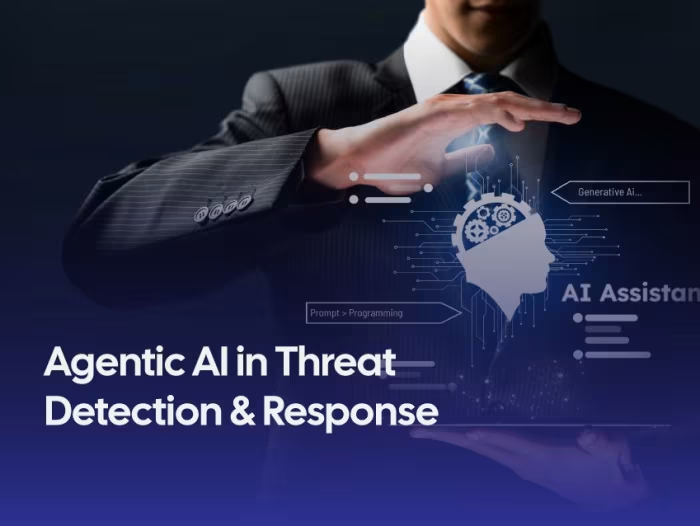Resource / Online Journal
Why AI-Generated Deepfake Phishing Is the Next Big Threat for Executives
Discover how AI-generated deepfake phishing attacks are targeting executives with hyper-realistic impersonations. Learn about real-world scams, detection challenges, and expert strategies to protect your organization.
Published on Oct 31, 2025

The Rising of AI-Generated Deepfake Phishing
Cybercriminals now exploit artificial intelligence and synthetic media to create deepfake videos, voice clones, and fake content for phishing scams. These attacks bypass traditional phishing defenses, using generative adversarial networks to replicate a legitimate person in video calls or audio messages, tricking employees to send money, share sensitive information, or approve transactions.
According to ThreatDown’s “Cybercrime in the Age of AI” report, phishing emails skyrocketed by a jaw-dropping 1,265% after ChatGPT’s release and that’s putting executives in the crosshairs of financial fraud, identity theft, and serious reputational damage.
What Is AI-Generated Deepfake Phishing?
AI-generated deepfake phishing is an advanced cyber threat where attackers leverage artificial intelligence, particularly generative adversarial networks (GANs) and large language models, to create synthetic media for malicious purposes. Unlike traditional phishing defenses that rely on spotting poor grammar or suspicious links, these attacks use AI to craft phishing emails that are flawless, contextually accurate, and highly personalized by analyzing public sources like social media and corporate websites.
Deepfakes add another layer of deception: hyper-realistic video calls, deepfake voice cloning, and fake content that make scammers appear as legitimate executives or even family members. Attack types include:
- AI-crafted phishing emails with perfect grammar
- Deepfake vishing (voice phishing) replicating an executive’s voice
- Video deepfakes simulating real people in virtual meetings
- Whaling spear phishing targeting high-profile leaders
These attacks aim to trick victims into sending money, sharing sensitive information, or approving fraudulent transactions, leading to financial loss, identity theft, and erosion of public trust.
Defending against this evolving threat requires adaptive security: AI-driven anomaly detection, behavioral analysis, out-of-band verification, and continuous employee training to recognize fake content and report scams before attacker's act.
Why AI-Generated Deepfake Phishing is the Next Big Threat for Executives
Executives are prime targets for AI-generated deepfake phishing attacks because of their roles as decision-makers and financial controllers. Their authority makes them ideal for phishing scams involving requests to send money, approve transactions, or share sensitive information. Attackers exploit public sources such as social media profiles, interviews, and speeches to train generative adversarial networks and create synthetic media like deepfake videos and deepfake voice recordings that appear legitimate.
Real-world examples underscore the risk: a $25M financial fraud at a multinational firm occurred after scammers used a video call deepfake of a CFO. Similar incidents involving CEO impersonation have led to severe financial loss, identity theft, and erosion of public trust. Beyond monetary damage, these attacks can trigger regulatory penalties, harm stakeholder confidence, and tarnish brand reputation.
Organizations must train employees to recognize fake content, implement adaptive security measures, and verify high-risk requests through out-of-band communications. In the age of AI-driven phishing, protecting executives is mission-critical.
Deepfake Phishing Attacks; Scale and Growth
The 2024 IC3 Report recorded over 193,000 phishing complaints, with losses exceeding $1.45 billion. The FBI warns that deepfake-enabled scams are escalating, especially in executive impersonation cases. Attackers now use synthetic media, deepfake videos, and voice cloning to bypass traditional phishing defenses, targeting executives in high-risk industries like finance and insurance. These AI-powered attacks are harder to detect and increasingly target critical infrastructure, reinforcing the urgency for multi-layered defenses and employee awareness.
Challenges in Detecting and Preventing AI-Generated Deepfake Phishing
Traditional Security Limitations: Static heuristics, signature-based detection, and grammar checks fail against polished phishing emails and fake content crafted by AI, leading to high false negatives.
Deepfake Audio/Video Realism: Hyper-realistic deepfake voice and video calls make impersonation nearly indistinguishable from legitimate communications. Fraud incidents surged 1,700%, and human detection accuracy is barely above chance.
Lagging Detection vs. Generation: The arms race between attackers and defenders means detection tools often trail behind. Emerging multimodal detection (voice, video, behavior) shows promise but requires heavy investment.
Behavioral Analytics & Training: Organizations need anomaly detection, contextual risk analysis, and scenario-based employee training to recognize subtle signs of deepfake vishing and phishing scams.
Combating these threats demands adaptive security, AI-driven detection, and robust incident response playbooks tailored for executive impersonation.
Strategies to Protect Executives from AI Deepfake Phishing Threats
AI-generated deepfake phishing identity protections are must as they grow more sophisticated to safeguard high-risk executive roles. Key strategies include:
Zero Trust Security Framework: Based on NIST guidelines, Zero Trust enforces “never trust, always verify.” It applies least-privilege access, continuous identity checks, and real-time monitoring to reduce risks even if credentials are compromised.
Multi-Factor Authentication (MFA): Adding multiple authentication factors makes it harder for attackers using deepfake voice or video calls to bypass security, mitigating phishing scams and financial fraud.
Real-Time Executive Digital Identity Monitoring: Detect spoofed accounts, fake calendar invites, and unusual communication patterns using AI-powered tools that analyze behavioral anomalies.
Employee Training on AI Threats: Teach staff to recognize synthetic media, deepfake content, and subtle signs like unnatural audio or context mismatches, going beyond traditional phishing awareness.
AI-Powered Threat Detection: Deploy solutions that identify polymorphic phishing emails, deepfake videos, and voice cloning signatures, improving early detection.
Incident Response Playbooks: Prepare clear protocols for executive impersonation and deepfake vishing scenarios to minimize financial loss and reputational damage.
These measures combine adaptive security, human vigilance, and advanced technology to counter evolving threats targeting executives.
Conclusion
The rise of AI-generated deepfake phishing attacks is staggering. Attackers now use synthetic media, deepfake videos, and voice cloning to bypass traditional phishing defenses, targeting executives in high-risk industries like finance and insurance. To safeguard your leadership team and critical assets, contact cybersecurity service provider TechDemocracy. Our advanced threat intelligence and executive protection solutions are designed to counter the evolving tactics of AI-driven adversaries.
Recommended articles


Defending Against AI-Generated Phishing and Deepfake Impersonation
Take Your Identity Strategy
to the Next Level
Strengthen your organization's digital identity for a secure and worry-free tomorrow. Kickstart the journey with a complimentary consultation to explore personalized solutions.